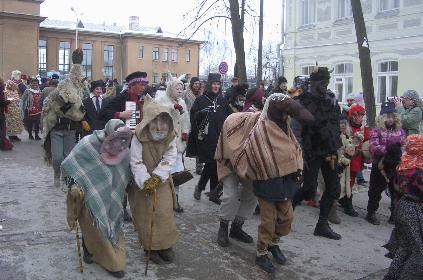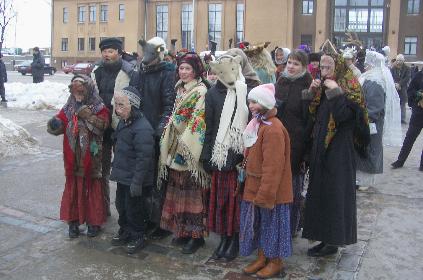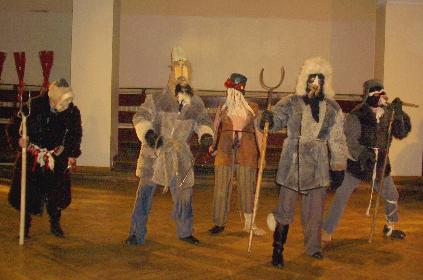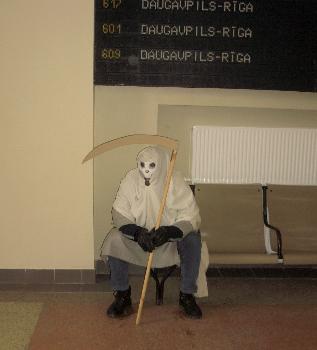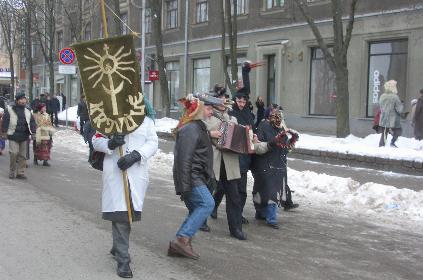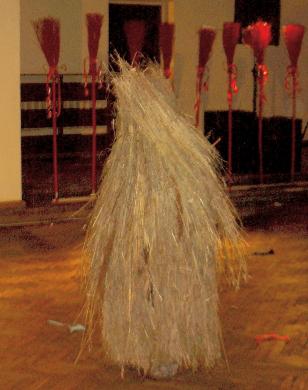|
|
|
|
|
Folklore groups
Instruments Activities About us |
|
|
|
Calendar
Regular Reportings Education |
|
|
|
Support
Fonts Mpeg3 Links Addresses Statistics Guestbook |
|
|
|
You are visitor of folklora.lt and visitor of this page. |
|
Masking traditions festival, Daugavpils,
Where, as not in a festival of masks, it is possible «to show ourselfs, and to
look at people»? Sure, you should show «Not-Us», and to look at «Not-People»,
otherwise the sense of the disguise can be lost. And, apparently, it appears very easy, but no,
you can not to run away from yourself and to hide under a mask.
This year the festival was divided: a part of ensembles has left to Ilukste, and
I can only guess, what they did there. In Daugavpils excepting «Not-Us» - the group
Ilyinskaya pyatnica,
were also a lot of «Not-Peoples»: Skandinieki from Riga,
Krivule from Vilnius (Lithuania), Svatra from Daugavpils, Zdravica from
Ventspils, Mezha from Tver (Russia) and others.
I think, that it is not necessary to introduce Skandinieki - they are
a group, who is on the front line of Latvian folklore movement from it's
beginning until now. Krivule I saw for the first time, however, it is
one of oldest Lithuanian ensembles. The vital experience maked them wise and
one can see it in any thing they are doing. Hard-working Zdravica
continues to assert their positions of life and by the persistence even causes
some respect. As has told one known ethnomusicologist: «Their way is not a
choice, it is a destiny...» The only one new group for the Baltic space was
Mezha from Tver, and about them I wish to tell more detailed.
Not so frequently presently accomplishes to make a video of a process of manufacturing
of a mummer's costume, and less often - of his acting. Such staff is priceless, any
textual description can not replace it. One can describe as much as possible
a star sky, a war or even a death. But one who did not seen it, anyway will not
understand. Disguise is a text, reached us from apart. To understand it's sense,
it is necessary to know the language of this text: the lexicon, the grammar, the syntax
and, of course, the semantics.
Mummers there are on a border, mezha, separating This World from Other World,
and if you are still alive, and you see a true character of a ceremonial disguise,
most likely you will have strong sensations. If you don't have them, it means
that either you are already dead or the character is counterfeit.
The procession was very active: mummers talk with everybody, danced, asked some food, catched girls etc. The local people reacted differently, basically - very benevolent, but some tried to hide in nearest shops (anyway, it did not help).
One of the best episodes was procession visit in the town council.
The bear and his accompanying have got confused in corridors of municipality.
They came in all doors, inducing horror on officials, «studying» papers on
tables, or trying to capture a telephone.
Article: Sergey Alyonkin, 4 March 2004 |
|
Questions, comments and suggestions are welcome to ansis_N@N_folklora.lt This page is created with support of SFL, Latnet and Lanet. |
|
03 September 2018 |
